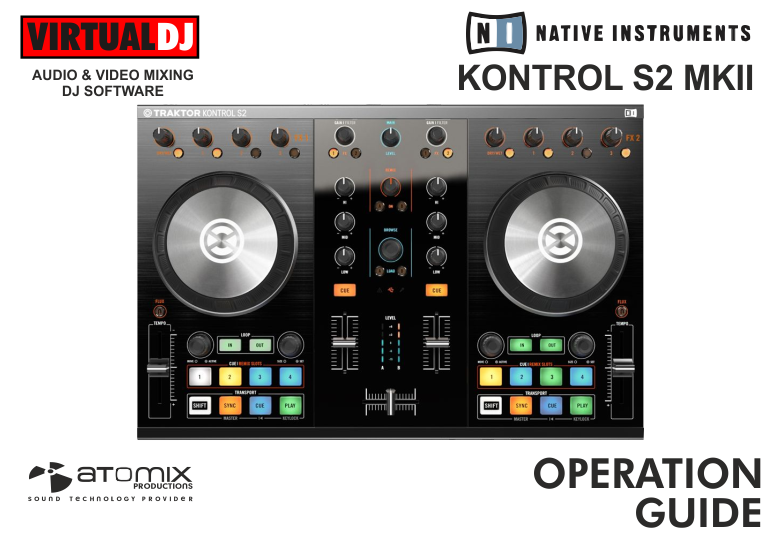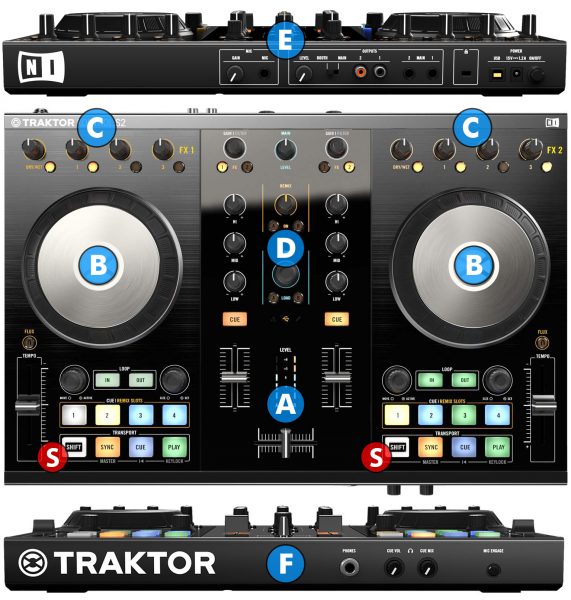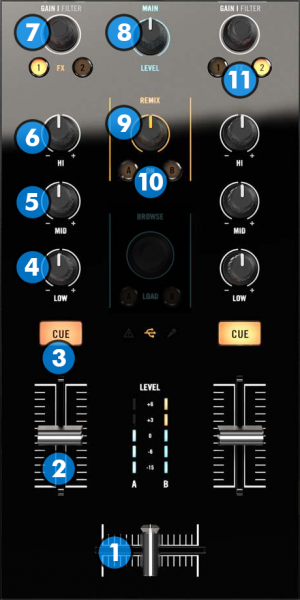NATIVE INSTRUMENTS KONTROL S2 MKII

INSTALLATION
Firmware: Firmware: Update the firmware of the unit to the latest version from Native Instruments
Drivers: Install the latest drivers from Native Instruments
VirtualDJ 8 Setup
(in case you have not done already)
Once VirtualDJ 8 is launched, a Login Window will appear. Login with your virtualdj.com account credentials. A Pro Infinity, a Kontrol S2MK2 Plus or a Pro Subscription License is required to fully use the Kontrol S2MK2
Without any of the above Licenses, the controller will operate for 10 minutes each time you restart VirtualDJ.
Buy a license

Click to OK.

Advanced Setup
The unit should be visible in the CONTROLLERS tab of Config and the “factory default” available/selected from the Mappings drop-down list. The factory default Mapping offers the functions described in this Manual, however those can be adjusted to your needs via VDJ Script actions.
Find more details at
VDJ Pedia

The unit has a pre-defined Audio setup and a special button in the AUDIO tab of Config to provide that. Alternative Audio setups can be applied in the same window.

For further software settings please refer to the Manuals of VirtualDJ 8.
LAYOUT
S SHIFT: Hold this button down to access secondary functions of the Kontrol S2MK2 (mainly in white lettering)

The functionality of each button, knob and slider per section (as shown in the image above) will be explained in detail in the next chapters
Mixer

- CROSSFADER: Blends audio between the left and right channels/decks.
- VOLUME: Adjust the output volume of each deck
- PFL: Press this button to send this channel's pre-fader signal to the Cue Channel for monitoring. When engaged, the button will be lit.
- EQ LOW: Adjusts the low (bass) frequencies of the corresponding deck.
- EQ MID: Adjusts the middle (mid) frequencies of the corresponding deck
- EQ HI: Adjusts the high (treble) frequencies of the corresponding deck.
- GAIN: Adjust the Gain (Trim) of the corresponding deck. Hold down SHIFT and turn this knob to apply a High Pass / Low Pass filter on the sound of the corresponding deck.
Press the knob down to reset (turn off) the filter - MASTER VOLUME: Adjust the level of the Master Output.
- SAMPLER VOLUME: Adjusts the Master Volume of the Sampler
- SAMPLER TOGGLE BUTTONS: Press these buttons to change the HOTCUE buttons to Sampler mode on the corresponding deck. Press again to return to HotCue mode.
- FX ASSIGN: Clone the effects from one deck to another. (see EFFECTS)
Deck Controls

- JOG: Touch sensitive jogwheel. Use the jogwheel to scratch or bend (depending on the Vinyl/Scratch mode selection) or fast seek through the track if the Search mode is enabled.
The Jogwheel also offers Loop In and Loop Out point adjustment (see Loop Controls) - SLIP: Enables Slip Mode. Several software functions (such as Jogwheel movements, HotCues and Loops) will apply temporarily on the track, and the track will return to the position it would have been if those functions were not triggered.
- PITCH: Controls the track's playback tempo.
Note: The actual pitch fader will not alter the pitch of the track if the actual pitch and the software pitch value do not match (software soft-takeover, ghost fader visible on the GUI). In most cases this may happen if SYNC is prior pressed or switching decks and the other deck is having a different pitch software value. - SYNC: Press this button to automatically match the corresponding Deck's tempo with the opposite Deck's (or the Master Deck’s if using a 4 decks Skin) tempo and phase.
Hold down SHIFT and press this button to set this deck as Master Deck (for 4 decks skins) - CUE: When the Deck is paused, you can set a temporary Cue Point by moving the Platter to place the Audio Pointer at the desired location and then pressing the Cue Button.
During playback, you can press the Cue Button to return the track to this Cue Point. (If you did not set a Cue Point, then it will return to the beginning of the track.).
If the Deck is paused, you can press and hold the Cue Button to play the track from the Temporary Cue Point. Releasing the Cue Button will return the track to the temporary Cue Point and pause it. To continue playback without returning to the Temporary Cue Point, press and hold the Cue Button, then press and hold the Play Button, and then release both buttons.
Hold down SHIFT and then press this button to return to the cue point. - PLAY/PAUSE: Plays / Pauses the track.
Hold down SHIFT and then press this button to toggle “Key Lock” on/off. When “Key Lock” is engaged the track’s pitch will lock to the current key when you move the Pitch Slider (14) to alter the tempo of the song. - HOTCUE/SAMPLER: These buttons offer two different operation modes depending on the status of Sampler Toggle Buttons (10).
On HotCue mode each one of the 4 buttons assigns a Hot Cue Point or jumps the track to that Hot Cue Point (if assigned). When a Hot Cue Button is unlit, you can assign a Hot Cue Point by pressing it at the desired point in your track. Once it is assigned, the Hot Cue Button will light on.
Hold SHIFT and then press a button to delete its assigned Hot Cue Point. .
On Sampler mode each one of buttons pads triggers a sample from the selected Sampler Bank of VirtualDJ. If a bank has less than 5 samples, both sides will control the same samples. If a bank has more than 5 samples, the left side will control samples 1 to 4 and the right side samples 5 to 8. Press the buttons to trigger a sample.
Hold SHIFT and press a button if you want to stop playing the selected sample.
- LOOP MOVE: Turn this knob clockwise (while in a loop) to move the loop forward in the track. The loop will move as many beats as the current loop. Turn the knob counter clockwise to move the loop backwards in time. The track playing position will jump in order to remain inside the loop at the same position. Press the knob down to activate/deactivate an automatic loop.
- LOOP IN/OUT: Use these buttons to set a Loop In and a Loop Out point (for manual looping). If “Smart Loop” is enabled in VirtualDj GUI, the Loop Out point will be automatically adjusted so that it creates a perfect seamless loop. While in a loop press the Loop Out button again to exit the loop.
While the deck is in a loop hold down SHIFT and press Loop In button in order to toggle the jogwheel between “Loop In Adjust” and “Jog” mode. When the jogwheel is in “Loop In Adjust” mode the led of Loop In button will blink. While in “Loop In Adjust” mode, you can use the JOGWHEEL (12) to fine tune the loop in point. Hold down SHIFT and press Loop In button again to return normal “Jog” mode.
Hold down SHIFT and press the Loop Out button (while in a loop) in order to toggle the jogwheel between “Loop Out Adjust” and “Jog” mode. When the jogwheel is in “Loop Out Adjust” mode the led of Loop Out button will blink. While in “Loop Out Adjust” mode, you can use the JOGWHEEL (12) to fine tune the loop out point of your loop. Hold down SHIFT and press Loop Out button again to return normal “Jog” mode. - LOOP SIZE: Turn this knob to adjust the size used by automatic loops, or to change the length of the current loop. Press the knob down to activate a momentary Loop Roll effect.
Effects

The Left FX section (FX1) controls the effects of the deck 1 and the Right FX section (FX2) controls the effects of deck 2. Use the FX ASSIGN (11) buttons to copy the effects from one deck to another.
Each one of the FX unit offers 2 modes:
The Single Effect mode offers one effect slot but more parameters controls per effect.
The Multi Effects mode offers 3 effect slots (to trigger more than 1 effect at the same time – chained effects).
The selection between those 2 modes is done by pressing DRY/WET (22) button while SHIFT is held.
- DRY/WET Button:
In Single FX mode, it activates the current effect slot.
In Multi FX mode, it has no function.
Hold down SHIFT and press this button to toggle between Single FX and Multi FX modes. - FX1 Button:
In Single FX mode, press this button to enable/disable the the 1st button of the selected effect (if available). Hold down SHIFT to control the 4th button of the selected effect (if available).
In Multi FX mode, press this button to activate the effect selected on the 1st FX slot. Hold down SHIFT and press this button to select the next available effect for slot 1. - FX2 Button:
In Single FX mode, press this button to enable/disable the the 2nd button of the selected effect (if available). Hold down SHIFT to control the 5th button of the selected effect (if available).
In Multi FX mode, press this button to activate the effect selected on the 2nd FX slot. Hold down SHIFT and press this button to select the next available effect for slot 2. - FX3 Button:
In Single FX mode, press this button to enable/disable the the 3rd button of the selected effect (if available). Hold down SHIFT to control the 6th button of the selected effect (if available).
In Multi FX mode, press this button to activate the effect selected on the 3rd FX slot. Hold down SHIFT and press this button to select the next available effect for slot 3. - DRY/WET Knob:
In Single FX mode, turn this knob to select the current effect.
In Multi FX mode, it has no function. - FX1 Knob:
In Single FX mode, turn this knob to adjust the 1st parameter of the current effect (if available). Hold down SHIFT and turn this knob to adjust the 4th parameter of the current effect (if available).
In Multi FX mode, turn this knob to adjust the 1st parameter of the effect in slot 1 (if available). Hold down SHIFT and turn this knob to adjust the 2nd parameter of the effect in slot 1 (if available). - FX2 Knob:
In Single FX mode, turn this knob to adjust the 2nd parameter of the current effect (if available). Hold down SHIFT and turn this knob to adjust the 5th parameter of the current effect (if available).
In Multi FX mode, turn this knob to adjust the 1st parameter of the effect in slot 2 (if available). Hold down SHIFT and turn this knob to adjust the 2nd parameter of the effect in slot 2 (if available). - FX3 Knob:
In Single FX mode, turn this knob to adjust the 3rd parameter of the current effect (if available). Hold down SHIFT and turn this knob to adjust the 6th parameter of the current effect (if available).
In Multi FX mode, turn this knob to adjust the 1st parameter of the effect in slot 3 (if available). Hold down SHIFT and turn this knob to adjust the 2nd parameter of the effect in slot 3 (if available).
Quick Note:
Not all effects offer multiple switches (buttons) and parameters (knobs) to adjust their behavior. Therefore it's absolutely normal that in Single FX mode some buttons and / or knobs may do nothing when used.
Browser
- BROWSE:
Turn: Scrolls through files or folders. When SHIFT is pressed it changes the focused area between folders, songs and the sideview.
Push: Sets focus to the Folders list or opens/closes subfolders if focus is on the folders list. When SHIFT is pressed if focus is on the Folders list, enters the Songs List. If focus is on Songs list it loads the selected track. - LOAD: Press one of these buttons while a track is selected to load it on the corresponding deck. Press and hold the same button for more than 1 second, to unload the same deck.

Rear

- MIC VOLUME: Controls the volume of the mic. This control is hardware operated and its movement is not visible in the VirtualDj GUI
- MIC INPUT: Connector for your mic.
- MASTER LEVEL: Controls the master output volume of the device. This control is hardware operated and its movement is not visible in the VirtualDj GUI.
- RCA OUTPUTS: Use these connectors to connect your device on another mixer or consumer grade amplifier.
- BALANCED (TRS) OUTPUTS: Use these connectors to connect your device on a PRO grade amplifier or self-powered (active) speakers.
- USB CONNECTOR: Use a standard USB cable to connect Kontrol S2 MK2 with your computer.
- POWER INPUT: Connect the supplied power supply unit.
- POWER SWITCH: Turns on/off the power on the device.
Front

- HEADPHONES CONNECTOR: Connect your headphones.
- HEADPHONES LEVEL: Adjusts the Headphones (CUE) Output Volume (Hardware operation, not visible on the VirtualDJ GUI).
- HEADPHONES MIX: Adjusts the mixing between CUE and MASTER output sound output on your headphones. All the way to the left is CUE sound output only, all the way to the right is MASTER sound output only.
- MIC ON/OFF: Activates/Deactivates the MIC input (33) of Kontrol S2 MK2
